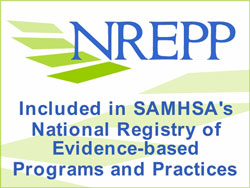Media Ready
Substance Abuse Prevention Program
for Middle School Students
for Middle School Students
Goals of the Media Ready program
- Encourage healthy cognitions about abstinence from alcohol and tobacco use
- Enhance students’ ability to apply critical thinking skills to interpreting media messages, in general, and alcohol media messages, in particular
- Delay or prevent the onset of underage alcohol and tobacco use

Program Structure
Grades 6 – 8
10 class sessions
Approximately 45 minutes/lesson
Instructional Materials
Comprehensive, easy-to-use, scripted Teacher’s Manual
Downloadable Handouts
Downloadable Student Workbook
Access to online Multimedia Presentation
Key Features
Alcohol and tobacco use prevention integrated into the excitement of interactive media literacy activities.
The program and lesson objectives are integrated with curriculum objectives in language arts, information skills, and healthful living.
Teaches critical thinking skills.
Based on state-of-the-art scientific research and theory on media literacy education and effective substance abuse prevention approaches.
Easy implementation for teachers.
Kit includes all materials needed to teach the program.
Curriculum adaptable to a variety of classroom settings, teaching styles, and student skill levels.
Curriculum adaptable to variety of learning environments including schools, afterschool programs, or community settings
Includes engaging homework and extension assignments designed to further students’ understanding of media and provide additional opportunities to practice newly learned skills.
What makes the Media Ready program unique?
Evidence-Based: It is one of the few, if not the only, evidence-based, media literacy education, substance abuse prevention programs currently available for use with middle school-aged youth.
Scope and Sequence: While there are hundreds of media literacy education activities, the Media Ready program includes the first randomized, controlled trial of a school-based, theoretically grounded, media literacy education program for alcohol and tobacco prevention. Media Ready is unique because the scope and sequence of the activities that were developed and organized to reflect the most up-to-date research findings in the fields of substance abuse prevention, social cognition, and media literacy education.
Fun, Interactive Learning: Although Media Ready has the goal of substance abuse prevention, students are not initially aware that prevention is the focus of the program. While exploring advertising techniques, alcohol, tobacco, and smoking advertisements are shown to the students as examples along with many other ad examples of other types of products and services.
Lessons Based on a Conceptual Model: Media Ready is based upon a conceptual model of how media messages are processed and has the goal of changing how students are able to think about and respond to media messages.
Teacher Training: Comprehensive training workshop for teachers includes introduction to the theory and research underlying the program.
Follows Standard Course of Study: The program and lesson objectives are integrated with curriculum objectives in language arts, information skills, and healthful living.
Curriculum is Adaptable: The curriculum is adaptable to a variety of classroom settings, teaching styles, and student skill levels and also to a variety of learning environments including schools, afterschool programs, and community settings.
Significant or Promising Prevention Findings: The Media Ready program reduces boysâ intentions to use alcohol and reduces boysâ and girlsâ intentions to use tobacco products. It is a promising preventive intervention program which should reduce the likelihood of underage drinking and increase the likelihood of delaying the onset of alcohol and tobacco use.
What are the findings of the Media Ready evaluation study?
The Media Ready program results show significant:
- Improvement in critical thinking skills about media messages;
- Reduction in boysâ intent to use alcohol products; and
- Reduction in studentsâ intent to use tobacco products.
The program was equally effective in 6th-, 7th-, and 8th grades, as well as equally effective in Language Arts and Health Education classes.
Why not just tell students that underage alcohol and tobacco is illegal and bad for them?
Media Ready students have found the journey from being a passive to active media consumer to be intellectually stimulating. Telling students that media messages are bad is not effective; nor is it true. Similarly, warning students of the dangers of alcohol use has not been a successful strategy on its own.
Media literacy education aims to empower students with the skills they need to draw their own conclusions about pro-substance media messages. To be sure, this is but one element in what must be a multi-faceted approach to the problem of youth substance abuse, but it is one that is designed to engage young people and spur them to action.
Is Media Ready easy to implement and teach?
Teachers involved in the evaluation study who attended the engaging and interactive one-day training program by iRT, found the program easy to learn and easy to teach.
iRT aimed to minimize teacher preparation by providing, whenever possible, all materials necessary for the activities that are included in the Media Ready program. This program was designed to be adaptable to a variety of different types of classroom settings, teaching styles, and student skill levels.
What is the content of the Media Ready program?
The curriculum concepts build upon themselves. The first part of the curriculum introduces students to many of the key concepts in media literacy, such as developing an understanding that all media messages have a target audience and being able to identify the target audience. Students also learn to identify the implied messages embedded in media messages as well as learn the seven key critical thinking questions regarding media messages. By learning and applying the key MR questions, students see the benefits of becoming active rather than passive media consumers. During the next part of the curriculum, students apply their new media deconstruction skills to the analysis and evaluation of a wide variety of ads including ads for food, cars, and beauty products. After substantial practice in the application of these critical thinking skills, students transition to deconstructing tobacco and alcohol ads. The curriculum culminates with a media production activity, which provides students with an opportunity to express their media production skills through the creation of an alcohol or tobacco counter-ad.
Teacher Training
Teachers involved in the evaluation study who attended the engaging and interactive one-day training program by iRT, found the program easy to learn and easy to teach.
iRT aimed to minimize teacher preparation by providing, whenever possible, all materials necessary for the activities that are included in the MR program. This program was designed to be adaptable to a variety of different types of classroom settings, teaching styles, and student skill levels.
The Teacherâs Manual contains 10 scripted lessons with accompanying:
⢠Goals
⢠Objectives
⢠Vocabulary words
⢠Teacher preparation list
⢠Lesson-At-A-Glance page
⢠CD of advertisements used in the curriculum as teaching aids
⢠Student worksheets for each lesson
⢠Homework
⢠Extension activities
⢠References and resources page.
How important is it to attend a teacher training workshop?
Attendance at a teacher training workshop is fundamental to success in implementation of the Media Ready program. This conclusion is based upon recent research by Hobbs and Frost (2003) who examined high school teachers implementing media literacy in their classrooms for one year. Â They found that at the close of the study, some teachers were still uncomfortable analyzing advertisements as well as guiding their students through the process.
This important finding is consistent with the idea that media literacy skills are a challenging set of critical thinking skills to master, even for adults. Because of the abstract nature of persuasive messages found in advertising, it is believed that a key element of this curriculum is to slowly and cumulatively build critical thinking and media deconstruction skills in both the adults teaching the program as well as in the students who are taking it. The educator training workshop and the cumulative nature of the Media Ready program are designed to enhance the likelihood that all participants will internalize these skills.
What is the content of the teacher training workshop?
The teacher training workshop is designed to last for one day and is led by the program developers and their training team, who are skilled trainers of both media literacy and the Media Ready program. After an introduction to the research on the effectiveness of media literacy training for the purpose of substance abuse prevention and the theoretical model underlying the program, trainers present each lesson in detail to trainees, providing guided discussion of the purpose of each activity, strategies for implementing each activity, and modeling of the activities.
Emphasis is placed on trainees receiving multiple opportunities for deconstructing media and for developing a deep understanding of the goals of the program manifested in the lesson activities.
Who developed this program?
The First Edition of the Media Ready program was developed by innovation Research & Training under a contract from the North Carolina âDepartment of Health and Human Services/Federal OJJDP Enforcing Underage Drinking Laws (EUDL) Program.
The funding for the updating of the program in the Second and Third Editions was provided by innovation Research & Training. The Media Ready program was written by Dr. Janis Kupersmidt, Dr. Tracy Scull, and Dr. Jessica Benson, leading clinical and developmental psychologists who are also substance abuse prevention scientists and experienced educators.

